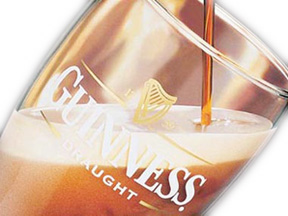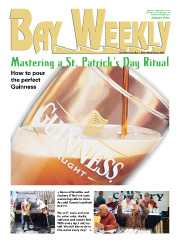Mastering a St. Patrick’s Day Ritual
How the perfect Guinness is poured

by Ariel Martinez Brumbaugh
St. Patrick’s Day is “all about having fun,” says Galway Bay bartender Tina Doyle. There is no gift-giving, no buying cards, no handing out candy, no bunnies, no Santas.
There is beer.
St. Patrick’s Day is the only nationally recognized holiday devoted to curing cenosillicaphobia, the fear of an empty glass.
Conquering cenosillicaphobia with a perfectly filled glass gets great attention leading up to March 17.
First, it must be filled with Dublin’s beer of choice, Guinness.
Guinness is no ordinary beer. The dark beer is smooth and rich but not overly powerful. The pleasant drinking experience is due to the nitrogen, according to Fadó Irish Pub manager Bernie O’Brien. Nitrogen, the Irish O’Brien says, creates a cascading effect and satiny texture unmatched by beers made with carbon dioxide. Guinness has other advantages as well: a very low 4.2 percent alcohol by volume and only 10 calories per ounce.
It also has a history. It was created in 1759 by Arthur Guinness, who signed a 9,000-year lease at the St. James Gate Brewery in Dublin at the cost of about $60 a year. This Guinness contract is considered one of the bargain deals of all time, right up there with the Louisiana Purchase.
Other rules are prescribed for the perfectly poured Guinness glass.
“It takes exactly 119 seconds to pour a Guinness,” O’Brien explains. “You have to pour the first three-quarters and then let it settle before you pour the last bit. You’ll know it’s settled when the cascading is done and the beer turns a ruby red.”
Hold your Guinness up to the light, and the apparent blackness is revealed to be deep redness. O’Brien is right.
For the past three years, the many rules of the Guinness pour have been practiced and perfected at a competition engaging the bartenders of two of Annapolis’ Irish pubs, Fadó and Galway Bay. Bartender Niall Gilsenan of Galway Bay was champion of the 2009 Perfect Pint competition. In this year’s competition, on March 8, Fadó bartender Robin O’Brien took the honor.
Whichever pub gets your St. Patrick’s Day custom, here’s what to look for when your Guinness is poured:
• Guinness should be poured into a clean 20-ounce tulip pint glass.
• The nozzle should not touch the glass.
• It should be a clean pour with no bubbles.
• The glass should be poured three-quarters full, then rest until the cascading is done.
• No crying from drops at the rim of the glass.
• The foam should have a Mushroom Head — a thumb’s width of foam — rather than a Bishop’s Collar, meaning no head taller than one-half to one inch.
• There should be clean lines at the top and base of the head.
|
![]()


